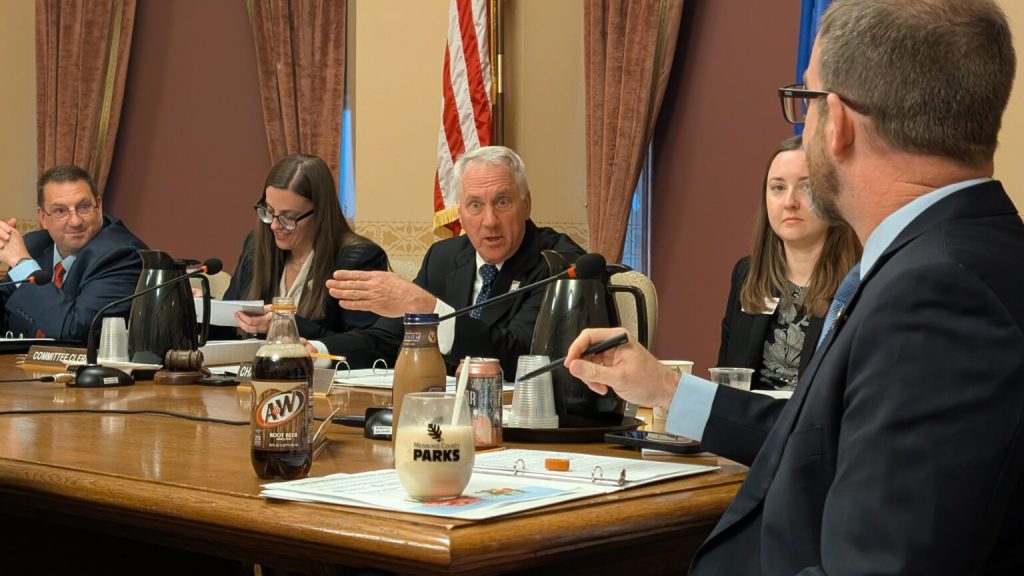Wisconsin Republicans Support ‘Junk Food’ Ban
Legislators target SNAP spending on candy, soda, inspired by RFK Jr.'s campaign.

Rep. Dan Knodl (R-Germantown) looks at the root beer float made by Rep. Ryan Clancy (D-Milwaukee) during the Assembly Public Benefit Reform Committee. Clancy made it as he was arguing the definitions in the bill were arbitrary and unclear. (Photo by Baylor Spears/Wisconsin Examiner)
Republican lawmakers are seeking to implement a pair of bills that would prevent low-income Wisconsinites from buying “junk” food and ban certain ingredients in school meals, taking inspiration from U.S. Health and Human Services Secretary Robert F. Kennedy’s “Make America Healthy Again” agenda.
Rep. Clint Moses (R-Menomonie), the lead author on both of the bills, has said he wants to help ensure the food children and others are eating is healthy.
AB 180 would bar participants in Supplemental Nutrition Assistance Program (SNAP) — or, as it’s known in Wisconsin, FoodShare — from purchasing soda and candy with their benefits. Under the bill, the Wisconsin Department of Health Services (DHS) would need to submit a waiver to the federal government for approval to make the change to the program.
Kennedy wants a similar policy implemented nationwide, and so far several states, including Arkansas and Indiana, have asked the Trump administration for a waiver that would remove soda and candy from SNAP eligibility.
Moses said at a hearing on the proposal earlier this month that by allowing people to purchase those items with FoodShare, Wisconsin is “facilitating consumption of harmful, additive-filled foods” and that “instead, we should be supporting healthy, sustainable food choices for [people’s] overall health of individuals, the health of our society as a whole.”
Moses argued the restrictions wouldn’t be a novel idea, since people already can’t use their SNAP benefits to purchase alcohol, pet food and other items. SNAP currently also can’t be used for hot foods (such as a meal at a restaurant), supplements and vitamins and nonfood items.
He also compared it to the Women, Infants & Children (WIC) program, the assistance program that provides free healthy foods, breastfeeding support, nutrition education and referrals to other services to income-eligible pregnant and postpartum women, breastfeeding moms and children under 5.
“Most government money has strings attached to what that money can be used for,” Moses told the Assembly Public Benefits Reform Committee. “Adding this provision is no different than the special supplemental nutrition program for the WIC program… WIC basically includes a list of good items or essentials that people can buy that does not include any of this other stuff.”
Expert: SNAP, WIC have different goals
UW-Madison food insecurity expert Judith Bartfeld says, however, that the programs are fundamentally different. WIC serves as a narrowly targeted nutrition program that provides specific foods for a defined group of nutritionally at-risk people.
The SNAP program, meanwhile, is designed to serve as a “supplement to existing income” and “to fill the gap between a USDA estimate of what is needed to meet a household’s food needs and the amount a given household is assumed to be able to spend on food out of current income,” Bartfeld wrote in an email to the Examiner.
She said periodic state and federal attempts to restrict SNAP have been unsuccessful in the past, in part because of a “reluctance to upset the balance for a program that is a backbone of the safety net.”
According to DHS, the SNAP program helps nearly 700,000 Wisconsinites put food on their tables annually. A USDA study from 2016, the most recent year, found that “there were no major differences in the expenditure patterns of SNAP and non-SNAP households, no matter how the data were categorized,” and that similar to other families, SNAP recipients spend about 20 cents of every dollar on sweetened drinks, desserts, salty snacks, candy and sugar.
“It’s intended to provide extra resources to support buying food at the store — and its effectiveness in reducing food insecurity is well documented,” Bartfeld said. “There have long been concerns that restricting how benefits can be used would make things more complicated for retailers, more stigmatizing for participants, unlikely to translate into meaningful health improvements, and would risk reducing participation and jeopardizing the well-documented benefits of SNAP on food security.”
In addition, she said, “identifying specific foods that are healthy or unhealthy is much more complicated in practice than it sounds.”
Bartfeld said SNAP combats food insecurity because it provides additional resources to low income people and has become “less stigmatizing and easier to use.” Restrictions, she said, could end up having a negative effect.
“If putting restrictions on SNAP ends up making it stigmatizing for participants, more complicated for retailers or opens the door to an increasingly constrained program, there are real concerns it may become less effective as an anti-hunger program — which of course would have negative health outcomes; this is why the anti-hunger community has long opposed bans such as this, and considered food bans as a line better not crossed,” Bartfeld said.
Bartfeld said it’s also unclear if a ban would improve health. Despite attempts to model health effects of a SNAP soda ban, she said, there is no empirical evidence proposed bans would meaningfully change diets or improve health outcomes.
“In contrast, there is real-world evidence that incentivizing healthy food purchases can modestly impact food choices,” Bartfeld said. “And SNAP has a nutrition education program (SNAP-Ed, which goes by FoodWise in Wisconsin), that appears to increase healthy eating — even as, ironically, that funding is currently at risk.”
The GOP-bill that passed the U.S. House of Representatives on Thursday included “some of the largest cuts in the program’s history” the SNAP program, according to CNBC.
The bill would expand work requirements to qualify for benefits, likely leading to reduced participation, cut federal funding and leave it up to states to fill in the gaps and it would entirely eliminate funding for the education program. According to Wisconsin DHS, the cuts would cost the state approximately $314 million every year and would put 90,000 people at risk of losing benefits. The bill now goes to the Senate.
Punishing low-income Wisconsinites?
Bartfeld said this is one of the challenges with some of the recent “health-focused” SNAP proposals across the county as the other proposed cuts and restrictions to the program are unrelated or “often run counter to health.”
“That interest in benefit cuts is happening in tandem with increasing attention to food choices does mean that food programs are at the center of the action, and it can make it challenging to differentiate proposals that are really about health from those that are more fundamentally about regulating the low income [population] and paring back assistance,” Bartfeld said.
Moses during his testimony described the proposal as part of a “national movement basically to really make our food supply healthier.” He said it shouldn’t be partisan and noted former First Lady Michelle Obama’s campaign to improve school meals.
“I expect to receive full support from not just the Legislature but the governor as well,” Moses said.
Democrats on the committee didn’t appear on board with the legislation. Rep. Ryan Clancy (D-Milwaukee) expressed concerns about the legislation focusing on low-income Wisconsinites and including unclear, arbitrary definitions.
Clancy asked Moses about low-income families using benefits to celebrate Halloween and special occasions. Moses replied that “if their kids really want candy, they can go into the neighbor’s house then they could trick or treat, and they’d probably get all the candy they want, but the benefit would be that the taxpayers wouldn’t be paying for it.”
“People that are on SNAP… they are taxpayers as well,” Clancy said, “so I don’t want to categorize folks who are experiencing, hopefully, temporary poverty from being taxpayers. They’re chipping in for, you know, health care benefits and everything else.” He added, “We’re, I think, just targeting low-income people with this.”
Clancy demonstrated his point by pulling out a bottle of Snickers-flavored iced coffee, a seltzer water and, at one point, a cup of ice cream and a bottle of root beer. He poured the root beer into the ice cream, saying the milk in it would make it acceptable to purchase under the definitions in the bill. The definition for “soft drink” is “a beverage that contains less than 0.5 percent of alcohol and that contains natural or artificial sweeteners” and “does not include a beverage that contains milk or milk products; soy, rice, or similar milk substitutes; or more than 50 percent vegetable or fruit juice by volume.”
“A root beer float is totally fine right? By taking this sugary thing, adding it to another sugary thing, this is now legal for somebody to use their FoodShare benefits,” Clancy said.
Committee Chair Rep. Dan Knodl (R-Germantown) told Clancy to stop, saying that the hearing “isn’t a cooking show.”
Banning additives in school meals
Another bill — AB 226 — would target “ultraprocessed” foods in schools by banning certain ingredients from meals, “Ultraprocessed foods” were one of the top concerns recently outlined by Kennedy and a report the Trump administration commissioned, and Kennedy has expressed interest in banning other additives as well.
Among the additives the bill identifies are brominated vegetable oil, potassium bromate, propylparaben, azodicarbonamide and red dye No. 3, which can be found in candy, fruit juices, cookies and other products.
Moses told lawmakers on the Assembly Education Committee that additives named in the bill are either in the process of being banned by the Food and Drug Administration (FDA) or have been subject of peer-reviewed studies that found links to adverse side effects if consumed in significant enough amounts. For example, Red No. 3 and brominated vegetable oil are both no longer approved for use in food by the FDA.
“Our school lunches should not be filled with substances that negatively affect our students’ health, even including their mental health,” Moses told the committee.
Moses said the bill would “bypass the need for federal action while not forcing schools to risk loss of federal funds to pay for existing school lunch programs.” He also noted that other states, including California, are also working to ban the ingredients.
The bill would go into effect on July 1, 2027.
An earlier version of the bill only included free- and reduced-price meals, but it was amended after concerns from the Department of Public Instruction and the School Nutrition Association of Wisconsin. Both now support the bill.
The Department of Public Instruction said the legislation aligns with positive trends in nutrition.
“With an increased focus on farm-to-school programs and the use of local food, school nutrition programs are helping to improve the nutritional value of meals,” Kim Vercauteren, policy initiatives advisor for the DPI Division for Finance and Management, said in testimony. “Many schools and school nutrition vendors are already committed to providing meals that utilize unprocessed foods, which can be enjoyed without harmful, nutritionally useless additives. These programs not only encourage the use of healthy food, but educate students on healthy lifelong choices.”
Targeted additives not common in schools
Members of the Healthy School Meals For All Coalition told the Wisconsin Examiner that they support the proposal, but also they hope it isn’t the only thing that lawmakers do to help improve school meals. The coalition of school food stakeholders has been advocating for free school meals for all Wisconsin students and for improving the quality of food served to students.
“We appreciate the fact that they’re looking out for the well-being of our students and see the work that we do,” School Nutrition Association of Wisconsin President Kaitlin Tauriainen said in an interview. “We’re hoping that some of these steps will allow us to build more of a bridge so we can understand each other’s point of view — whether that means taking steps to grant more access to food for kids or jumping right into the full meals for all free meals for all, which is something you know we certainly want.”
Tauriainen said that school nutrition professionals are focused on feeding students the healthiest food possible, although the ingredients listed in the bill already aren’t common in school meals.
“I would say the majority of our manufacturers that we’ve talked to don’t have those additives in their food,” Tauriainen, who is the child nutrition coordinator for the Ashwaubenon School District, said. “So it’s really kind of a non-issue.”
Allison Pfaff Harris, farm to school director with REAP Food Group, a Madison-based nonprofit, said she appreciates that the bill is trying to address the school food “supply side.” She said, however, that school nutrition programs need support in moving away from other processed ingredients not mentioned in the bill.
Operating on limited budgets, school nutrition programs “turn to those quicker ingredients, which are going to be more processed foods,” Pfaff Harris said, adding that “not all processed foods have those food additive ingredients.”
Pfaff Harris suggested pairing Moses’ bill with other improvements. She said the “big ask” for the coalition is no-cost school meals, but smaller steps would also be significant. Guaranteeing that the breakfast reimbursement for schools is 15 cents per meal could improve the supply chain and nutrition programs, she said. DPI prorates payments because it lacks funding to pay the full cost; Pfaff Harris said the current reimbursement rate is about 7 cents.
“This is one piece of the puzzle, but it’s a small piece in the giant puzzle,” Pfaff Harris said.
Pfaff Harris said the discussion about healthy meals is also challenging because there have been recent federal decisions cutting resources that help schools serve fresh ingredients. Wisconsin was set to receive $11 million in funding for “Local Food for Schools” programs, but it was cut by the Trump administration.
“You’re having these bills introduced, which is a good thing, but … from my perspective, if we really wanted to make a difference in school nutrition programs and help them to be able to do more scratch cooking and semi-scratch and fresh ingredients, it’s getting that funding back,” Pfaff Harris said.
Rep. Francesca Hong (D-Madison) asked Moses about free school meals and other proposals, saying it could improve his bill.
Moses said her suggestions seemed like a completely different bill altogether.
“It doesn’t matter to me if it’s reduced or people are paying for it. I want [the meals] to be safe …” Moses said. “Essentially, it’s not the intent of this bill.”
Joining national efforts, Wisconsin Republicans support ‘junk food’ bans was originally published by the Wisconsin Examiner.
If you think stories like this are important, become a member of Urban Milwaukee and help support real, independent journalism. Plus you get some cool added benefits.





















Clint Moses, where did I hear that name before? Oh Yeah!! He is the guy that wants to make it legal for the police to indiscriminately murder Wisconsinites!!